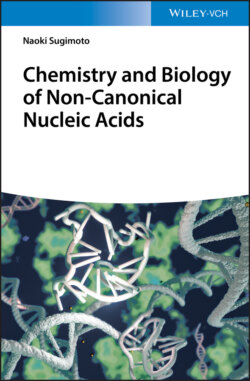Читать книгу Chemistry and Biology of Non-canonical Nucleic Acids - Naoki Sugimoto - Страница 39
2.6.3.5 GNRA Tetraloop Receptor Interaction
ОглавлениеGNRA, in which N is any nucleobase and R is purine nucleobase, is one of the two majorities of tetraloop sequences in RNAs. The other majority is UNCG, which contributes to the stabilization of hairpin loop structure, as described above. While GNRA tetraloops are thermodynamically less stable than UNCG tetraloops, they are more common in part because of their propensity to form tertiary interactions [34]. The last three nucleobases in the GNRA tetraloop are exposed to solvent and can interact with minor groove of other helices by forming hydrogen bonds. GAAA/11nt interaction is one of the classic motifs of the GNRA tetraloop interactions, which are observed in long-range interactions in large functional RNAs including rRNA, group I and group II ribozymes, and RNA unit of RNase P. In the GAAA/11nt interaction, a receptor helix has an internal loop with conserved sequence neighboring to consecutive two G·C base pairs. The last two nucleobases of the GAAA tetraloop interact with the consecutive G·C base pairs forming hydrogen bonding as similar way as the A-minor motif. Neighboring internal loop region forms characteristic stacked adenine nucleobases that support the interaction by forming hydrogen bonds with second adenine of the tetraloop (Figure 2.16).
Figure 2.16 Tetraloop receptor interaction. (a) General secondary structure of tetraloop receptor interaction. (b) Sequence and tertiary structure of typical GAAA/11nt tetraloop interaction (PDB ID: 2R8S). The RNA sequence is derived from Tetrahymena group I intron. Nucleobases involved in GAAA tetraloop and its receptor helix are emphasized dark. Hydrogen bonds between the GAAA tetraloop and the receptor helix are shown in dashed lines. Dashed lines in the secondary structure show connections between Watson–Crick base pair in the receptor and nucleobase in the GAAA tetraloop, at which at least one hydrogen bond is observed. Mismatched base pairs are shown with black circles in the secondary structure.
Figure 2.17 Pseudoknot structure. (a) Base pairing patterns on the primary sequence characterizing the pseudoknot structure. Lines show base pairing involved in pseudoknot formation of ribozyme region derived from hepatitis delta virus (HDV). (b) Tertiary structure of the HDV ribozyme precursor (PDB ID: 1SJ3). Extracted stem regions involved in the pseudoknot structure are shown on right. Numbers show the location of stems indicated at (a).
